Here's Everything I Know About Masonry
Well, maybe not e v e r y t h i n g.
After glass, brick is my favorite building material. Done right, it's timeless.
Concrete Masonry Units
Otherwise known as concrete block
But let's start with concrete block, or concrete masonry units [CMU]. CMU comes in modular sizes, but that doesn't mean the results will always look great. You have to pay attention to your dimensions.
The two most common vertical dimensions are 4" and 8", which include a 3/8" mortar joint. Dimensions are given to the top of the masonry unit in most instances and should be an increment of 8" to avoid 'issues'. The typical lengths are 8", and 16". The typical widths are 3-5/8", 5-5/8", 7-5/8", 9-5/8", 11-5/8" and 13-5/8". These are always referred to by their nominal width which is 3/8" larger. Of these widths, 4", 6", 8", and 12" are very common; 10" and 14" are sometimes special order, but that isn't a big deal.
CMU is an inexpensive structural material, allowing two or more functions to be met with one construction operation. CMU is as large as it will ever get when it is first made. Over the following years it will shrink very slightly. This shrinkage needs to be accommodated by contraction joints (planned cracks) or you will get random cracks. Random cracks are never attractive, and they annoy building owners - a lot. Place a vertical contraction joint [CJ] about 6' from corners, then 24' on center and wherever the wall height changes. Windows and doors are favorite places for random cracks. Try to place a CJ at the jamb of the door or window unless one of those 24' O.C. joints occurs nearby.
This NCMA (National Concrete Masonry Association) publication, although a bit too comprehensive for architects, contains really good, universal information about CMU. It is a good reference for almost any issue you might have.
Brick
Let's move on to brick. Unlike CMU, brick is a clay product that is heated in kilns to harden it. Bricks are made in modular sizes for the most part. But you should be aware that not all bricks are modular, and lengths, in particular, can be significantly different than 7-5/8". If you are using non-modular brick, you will have to trust your mason to make it work, and he will.
The most common modular brick heights are 2-1/4", 3-5/8", and 7-5/8". The brick that everyone is familiar with is 2-1/4" plus 3/8" mortar joint and three bricks and three mortar joints equals 8". Actually it adds up to 7-7/8", but either the mason makes up the 1/8" difference or the bricks are actually slightly larger. In either event you don't have to worry about it - it always works out to 8". The typical lengths are 8", 12" and 16". The usual width is 3-5/8".
Some bricks that are intended to be structural are 5-5/8", 7-5/8", or 11-5/8" wide. These are always referred to by their nominal width - add 3/8". Lengths and heights larger than the standard modular brick have names like 'utility', 'jumbo', etc. I don't trust every brick maker to use the same names for the same sizes, so I always spell it out somewhere - specs or drawings. I'm probably out of touch. But I’ve never been surprised.
Since brick is a fired clay product, it is as small as it will ever be when it is made. Over time brick swells ever so slightly. This is the opposite of CMU and ignoring this fact can create problems. Joints in brick are expansion joints to allow for this swelling. If you have a composite masonry wall with CMU and brick, they should be separated by an air space. The spacing and placement of expansion joints is similar to the CJ in CMU. For convenience they normally align, but they don't have to.
In buildings that have ANY masonry, when you don't consider coursing for most of your vertical heights, you will be sorry. For example: 6'-8" doors with a 2" frame requires a special lintel or cut pieces are required to use a standard lintel; ditto for non-coursing window heads; floor-to-floor heights that aren't coursing will require a cut course which will be visible in your stairs. When you are aligning floors with an existing building that is non-coursing, consider a ramp to eliminate all the awkward masonry situations. Also be sure to match exterior brick coursing, which I think looks especially amateurish when it is mis-matched.
One last thing, CMU should never be used for a single thickness exterior wall without a paint-like coating. Notwithstanding all the marketing blather to the contrary, this is a bad idea. Even a water-repellant “painted” on an integral color block erodes and won't be replaced until too late. If you want the single width, spend a little more and use a single-width brick product.
The longer I think about masonry, the more nuggets I could come up with, but you will be well-served to bookmark the resources below and download the catalogue mentioned above. As I said at the outset, brick is my favorite building material ... timeless.
What I don't know about masonry (or forgot to include here) can be found by a quick search. For CMU resources search for: NCMA TEK
For brick resources search for: Brick Technical Guide.



